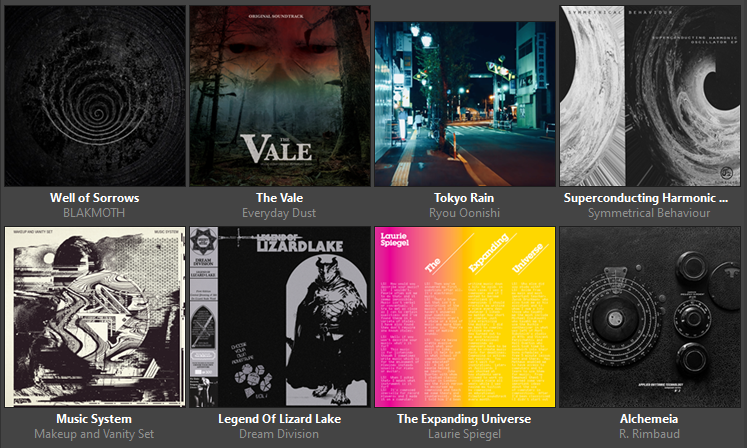Two things:
- the Verbos Harmonic Oscillator was supposed to be delivered today. Instead, I got a “Delivered” notification from FedEx that says I signed for it (with a random squiggle that’s not one of my random sqiuggles). But there was no truck here, no dogs barking, no knock on the door, and no box with electronic goodies inside. UPS did this with some coffee I ordered a few months ago; with FedEx it was was a little easier to get past the gatekeeping automated system and have an actual human start investigating it. [UPDATE] a few hours later, it was actually delivered, and I’m playing with it now. More on that when I have some coherent thoughts!
- my supervisor at work is leaving for another job, as of July 1. This is something I was nervous about before, and was a factor in applying to Noise Engineering: I don’t want to do management stuff, I just want to write code. Now that it’s been announced I’m…. kind of numb to it. One of the final things K is going to do is my performance review, so maybe I will get a bigger than normal raise out of this or something, since I will now be the senior developer on the staff…? At any rate, there will definitely be some discussion of things.
- a third thing: today is not Bandcamp Friday (where Bandcamp waives their cut of proceeds and the artist gets it all, aside from credit card processing fees)… but they are donating proceeds to the NAACP for Juneteenth. So I filled out my music collection with 8 more albums and emptied my wishlist again.

I’ve been culling my music library a bit faster than I’ve been adding to it. Stuff I just don’t have much interest in listening to repeatedly anymore, or honestly was never that much into in the first place, gets set aside. Not deleted though, in case I change my mind. Currently, the main library has 690 artists and 925 albums, and the archive has 264 artists (no easy way to count albums, but probably about 280?)
For music at work, I’m using a VeraCrypt-protected USB stick (not because my music library is a huge secret, but because all portable drives must be encrypted by policy), which will be perfectly synchronized with my main music library before I bring it to the office. And I’m also using an encrypted cloud storage service: syncing my music library, current works in progress and some other stuff from my home machine up to the cloud, and syncing it down to the portable drive. I don’t know whether I want to try two-way sync — if the USB stick gets its encryption locked or is removed but the sync monitor is running, will it think all those files got deleted and try the same in the cloud? This isn’t a big burden for my music library, but for password management (which I definitely don’t want to get broken) I’ll have to be sure that changes are made only from home.
- And a fourth thing: a few weeks ago I mentioned that Linda Nagata’s Vast was one of my favorite books, but I had not previously made the effort to track down the rest of the series. I got used paperbacks through Alibris and started on “Book 0” of the series, Tech-Heaven. It is almost not recognizable as the same setting.
Vast is in the far future, centered on a spaceship whose “soul” is the uploaded consciousness of a criminal who was sentenced to separation from his body and servitude in the fleet; the other crew are humans whose bodies are modified for space to varying degrees; the conflict is an encounter with an automated ancient battleship left over from a war that ended before life even crawled out of Earth’s oceans. If I remember right, Earth was long ago mined for materials to build a Dyson sphere, which was then lost in a nanotechnological plague that was part of a religious war? Something like that.
Tech-Heaven though? An early 90s vision of clunky VR-helmet cyberpunk, with orbital colonies just beginning. The main plot is that a man is preserved cryonically in hopes of future revival, by his wife’s wishes but against the objections of his sister, who happens to be a powerful and influential senator. His wife has to endure her next decades not really sure what to think of her relationship status to anyone. His sister winds up leading an anti-technology conservative faction that, oops, spawns terrorist groups and a whole new political movement that becomes a de facto government as old nations lose their cohesion. The man himself, not much of a participant in things at least so far, has really bad dreams loosely connected to whatever small bit of consciousness is still hanging on after he’s declared legally dead and goes through the freezing and/or revival process.
All this is to say, this is definitely not the same kind of book. The line of continuity between this book and Vast seems tenuous at best, though of course I will be better able to judge that after reading the whole series. The writing itself doesn’t come off as assured and as brain-grabby. It took some time to get into it, and I’m still mainly just skimming the nightmare stuff. And when the frozen guy’s wife interacts with certain other characters, it’s like Charlie Brown and Lucy with the football every damn time and I really wish she would learn.








